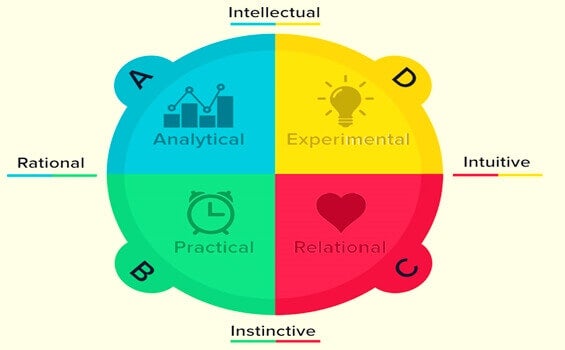Herrmann’s Brain Dominance Test is a 120-question tool used to figure out how each person processes information and what their particular learning style is. In this curious model, the brain has four quadrants. In general, we all have a certain predisposition to one of these typologies.
It is quite possible that one of our readers has passed this test at some point, however, it must be said that this is not very common. Herrmann’s brain domination instrument? (HBDI) is not neurologically valid and, moreover, many scientists say that this is part of what we often call the “psychology of pop”.
“The brain is not a cup to fill, but a lamp to light. Plutarch?
The issue of brain dominance and lateralization is highly controversial, for example, this instrument explains that creativity is exclusively in the right hemisphere, it is worth saying that this data is not entirely correct, because creative processes actually use the whole brain. in sophisticated and wonderful neuroactivity.
Does this mean Herrmann’s brain dominance test is useless?No way. There is one aspect that makes it valuable and, therefore, it is recommended to bring it into our space. This test is based on an important premise: each person has a particular way of processing, transforming, inducing and interpreting data.
This is very clear when we see several students in the same room studying or even when we are working ourselves, are there more thorough, conservative, innovative people, some more visual and others who treat information more audibly or communicatively?to the hypothesis discussed in the Herrmann test, and this is the classification it can offer us.
Before talking about this instrument developed in the 1990s, it is worth talking about its creator, Professor Ned Herrmann, who was president of the American Creativity Association and one of the pioneers in creative thinking and reasoning, specializing in physics and music, worked at General Electric from an early age with one goal: to improve the production, motivation and creativity of employees.
To do this, Herrmann analyzed the different styles of thought and learning of all workers, creating a map of the brain, from there he developed the theory of brain quadrants to enunciate 4 typologies, four different ways in which people are supposed to learn, think, create, interact and understand reality.
This brain domain is described below
Ned Herrmann called them experts. It is a profile characterized by a logical, analytical and more technical thinking style.
As the word itself explains, we are faced with a kind of organized profile, in love with order and meticulousness.
Type C refers to the domain of the brain that tends to be emotional, the need to connect with others, to relate to enjoy a social contact with which to feel useful, give and receive.
They are people who know how to communicate, who are spontaneous, outgoing and who tend to prefer jobs such as journalism, nursing, social work, advocacy, etc.
The fourth profile of this brain mastery test refers to this personality characterized by a holistic mentality, they are visual, spontaneous and highly creative profiles.
They are people who like to experiment and innovate, even if they have associated risks, they are always looking towards tomorrow, but they try to learn from the present so that they can go further every day.
Thus, the professions that usually include type D are architects, writers, musicians, painters, designers, etc.
In conclusion, after seeing these four types of Herrmann brain dominance tests, more than one person may not identify with a single area, it is common. In fact, estimates of the Herrmann Brain Dominance Instrument (HBDI) indicate that nearly 60% of the population generally has characteristics in more than one of these four areas.
However, it is important to emphasize that no domination is better than another and that they do not determine or predict anything, they only indicate the direction we usually have when interacting with our environment, or our resulting data processing style. way to get to know each other a little bit more.

